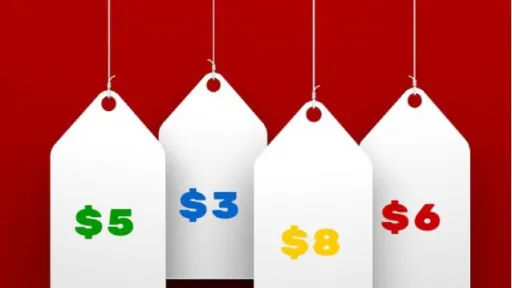Nowadays, it is important for an online store to keep a close eye on the strategies of your competitors. One of the most important aspects you should definitely consider is the pricing strategies used. For online shoppers, it is easy to compare prices between different providers. Therefore, it is crucial that you have an overview of the prices your competitors are using for the same products.
With the help of a price monitoring tool, you can obtain and analyze price information from your competitors within your sector or industry and use this data for your online strategy.
Why is this interesting for you? Price monitoring tools bring a range of benefits, showing you how to smartly apply this in your Google Ads campaigns. In this blog, we will guide you step by step through what price monitoring is, the possibilities it offers you, and how you can incorporate this into your Google Ads strategy.
What is price monitoring?
Price monitoring is the continuous observation and analysis of price information for products or services within your market. This means that price changes are continuously monitored to gain insights into market trends and competitors' pricing strategies. This is especially useful in sectors with a lot of competition and price changes.
Just like comparison websites, price monitoring tools scrape price data from websites, APIs, and databases. Within Google Shopping, a price monitoring tool can efficiently look up European Article Numbers (EAN), retrieving price data from all your competitors. This generates a clear overview of the market, allowing you to easily identify your main competitors and immediately notice price differences.
If you run an online retail business, price monitoring can help you adjust your pricing strategies to maximize profit and increase your brand value.
The benefits of price monitoring
A price monitoring tool offers numerous benefits for companies that want to remain competitive and optimize their online marketing strategies based on this.
Below are some of the main benefits:
Insights into the competition
Price monitoring provides valuable insights into your competitors' pricing strategies and can show you how your product prices compare to each other.
For example, if you sell shoes, you can use a price monitoring tool to track the prices of shoes at rival retailers, seeing how the price of each model rises and falls over time.
This knowledge helps you adjust your pricing strategy and remain competitive, for example by increasing the prices of some models and lowering those of others. The goal is to attract more customers and improve sales performance.
Optimized pricing strategies
By keeping track of prices, you can spot trends and patterns in prices over a longer period. Instead of pricing items based on intuition or gut feeling, you can now use a data-driven approach with historical and real-time price information.
The collected price data can be used for price optimization, such as setting dynamic prices, offering discounts at strategic times, or adjusting prices based on fluctuations in demand.
Increased profitability
By keeping an eye on competitors' prices, you find the optimal balance between maximizing profit and remaining competitive. This means charging enough to make a profit on each sold item, but not so much that you price yourself out of the market.
Collecting price data helps you understand market dynamics and consumer behavior, such as how much your target audience is willing to spend on the items you sell. You can then make strategic price changes to increase sales volume and boost your overall profit margin.
Price competition within Google Merchant Center
The simplest way to gain insight into how your prices compare to the competition is by Googling the product. However, this is time-consuming if you have multiple products.
If you advertise with Google Shopping, you can get a good overview of the price competition directly from your Merchant Center.
The advantage of the price competition report is that you don't have to set anything up to gain insights. It is directly available within your Google Merchant Center.
The report is not a replacement for price monitoring software, but it can be the first step in gaining insight into your product prices.
However, there are a few things you should be aware of before you start using it.
- You cannot see which products you are being compared to.
- The price benchmark can be based on products that are not entirely identical but are in the same auction as your products. This is not a foolproof system if you sell generic products for which Google cannot use Global Trade Item Numbers (GTINs) to compare.
- It is not a 100% live price monitoring report. Price information is not available live when you need it, so it is not useful for live bid changes.
Price monitoring data within Google Ads
The main idea behind using price monitoring data is to stay one step ahead of your competition.
As we have shown, your price is a decisive factor in selling your products. Translated into Google Ads terms, your price is crucial in increasing or decreasing your conversion rate and ROAS.
Example:
If our products were priced the same as our competitors last week and we had a ROAS of 500%, but this week our products are 20% more expensive than our competitors', it leads to a lower ROAS.
Because our products are more expensive than the competition, the following occurs:
Lower attractiveness
Price-sensitive consumers are more likely to buy from the competitor if they offer lower prices for the same product. This can lead to a lower click-through rate (CTR) on your ads.
Lower conversion rate
Even if consumers click on your ad, they are less likely to make a purchase due to the higher price, resulting in a lower conversion rate.
Target ROAS not achieved
If your target ROAS is, for example, 500%, and you only get 300% back due to lower conversions and higher costs, your target is not met. This can lead to the automated bidding strategy trying to adjust bids to improve performance.
For example, the automated bidding strategy may decide to lower bids to save costs and improve efficiency. This results in fewer ad impressions and clicks.
What you need to know before optimizing Google Ads
While it is generally believed that you cannot be profitable if your products are more expensive than your competitors', this is not always the case.
However, too many marketers rush and exclude products they cannot compete with.
A better option is to lower your target ROAS for these products.
Why lower it?
- Competitive bidding:
By lowering your target ROAS, you are willing to bid more per click, which can help generate more clicks and conversions, even if your product price is higher than your competitors'. - Retain market share:
This can help retain market share by increasing your visibility and attracting potential customers despite the higher price.
In addition to adjustments in your target ROAS, there are alternative strategies you can consider.
Price adjustment
If your margins allow, you might consider lowering your prices to be more competitive.
Product differentiation
Focus on the unique aspects of your product (USPs) that justify the higher price.
Additionally, it is also important to communicate all the benefits that make your company stand out, such as free shipping, better warranty, or excellent customer reviews.
Application of price monitoring within Google Ads
We recommend prioritizing your different products based on price data and profit margins and then organizing them into different campaigns.
For example, products that have a better price than the competition (cheaper) and achieve a high profit margin are given high priority.
We do this by allocating more budget to this campaign and setting a higher target ROAS.
Neutral products in terms of price and margins receive medium priority.
Products that are more expensive and have lower profit margins receive low priority.
Conclusion
Price monitoring tools provide valuable insights into competitive prices, optimize pricing strategies through data-driven decisions, and increase profitability through strategic price adjustments based on market data and consumer behavior.
Furthermore, we can categorize our products based on price data and integrate them into our Google Ads campaigns.
By categorizing your products based on price and profit margins and aligning your campaigns accordingly, you can advertise more efficiently and improve your ROI.
High-priority products receive more budget and a higher target ROAS, while products with lower priority receive less budget and a lower target ROAS. This ensures that your advertising budget is optimally utilized and you remain competitive within your market.
Do you have questions about how to integrate a price monitoring tool within your Google Ads or do you have another online marketing question?
Feel free to contact us.




